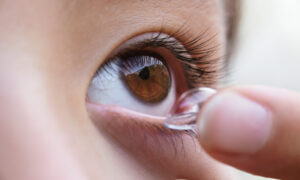May 1, 2024
By Dwight Akerman, OD, MBA, FAAO, FBCLA, FIACLE
It is often said that juvenile-onset myopia generally stops progressing by age 18. However, it is abundantly clear that many myopes continue progressing into adulthood and that many previous emmetropes develop myopia after age 18. Research suggests that the highest risk factors for adult myopia progression and onset appear to be extensive near work with short working distances, high AC/A ratio, and high accommodative lag.
The seminal NEI-funded COMET Trial (2013) enrolled 469 ethnically diverse children aged 6 to 12 years with spherical equivalent refraction between −1.25D and −4.50D. Of the original cohort, 426 had at least seven measurements over 11 years of follow-up. The trial showed that around a quarter of myopes are still progressing at age 18, 10% at age 21, and 4% at age 24. These data may underestimate the actual age when myopia stabilizes, as they only include myopia that developed at a relatively young age.
Parssinen et al. (2014) reported a mean progression of -0.45D +/- 0.71D over eight years in 147 subjects ranging from 23 to 31 years old. In 45% of cases, progression was ≥0.50D, and in 18% of cases, myopia increased by ≥1.00D. Likewise, Bullimore et al. (2008) reported that 16% of 219 myopes (mean age = 31 years) progressed by at least -0.50D over five years.
Lee et al. (2022) reported on a prospective eight-year study conducted in Australia. The researchers studied the incidence and progression of myopia in the third decade of life. Participants were examined at age 20 years and age 28 years. The final analysis included 691 participants. A myopic shift of at least -0.50D was observed in 37.8% of participants. The findings suggest that myopia progression continues for more than one-third of adults during their 20s, albeit at lower rates than in childhood.
Khan et al. (2023) retrospectively analyzed a large clinical dataset of subjective refraction results from 700 eyes of 354 young adult myopes (age range 18-30 years). Longitudinal, non-cycloplegic subjective refraction data for young adult myopes (spherical equivalent refractive error, -0.50 D or more), ages ranging from 18 to 30 years, were retrospectively analyzed. The proportion of those who progressed by -0.25D/year or more was 18.3% in the 18-21 age group, 10.9% in the 22-26 age group, and 8.8% in those older than 27 years of age. These findings support that myopia progression in young adults is a function of age and is influenced by greater visual workload.
What should eye care professionals do to treat progressing myopia in adults? We must rely on our clinical judgment in the absence of an evidence-based approach. Although adult myopia progression is frequently encountered in clinical practice, we have few peer-reviewed publications to guide management. However, data is beginning to emerge. Given that both juvenile and adult myopia progression are due to axial elongation, it is reasonable to believe that established modalities would be effective in adults, but it is difficult to predict their efficacy.
Progressive addition lenses (PALs) have limited efficacy in myopia control among children, so other myopia control options should be considered in adults. However, PALs may make a patient with accommodative issues more comfortable. Ergonomic advice may also make the adult myopic patient more comfortable and productive, but there is no evidence of it slowing myopia progression. Ninety to 120 minutes per day of outdoor activity may influence onset but may not affect progression. Overnight orthokeratology, dual-focus/EDOF soft contact lenses, and next-generation spectacle lenses should all be discussed with a motivated patient. Adults will likely be more visually demanding than children, so visual quality with the various options should be part of the conversation.
Best professional regards,
Dwight H. Akerman, OD, MBA, FAAO, FBCLA, FIACLE
Chief Medical Editor
dwight.akerman@gmail.com















